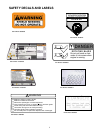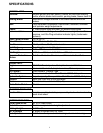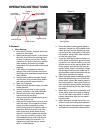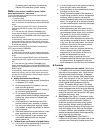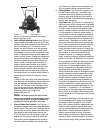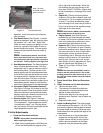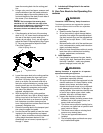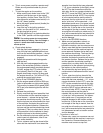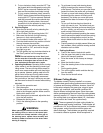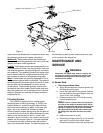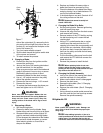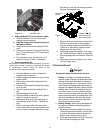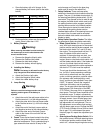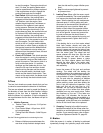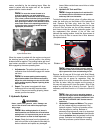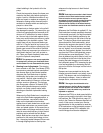
16
2. To turn clockwise, slowly move the LEFT lap
bar forward while simultaneously moving the
RIGHT lap bar rearward. Release both lap
bars and the machine should stop turning.
3. To turn counter-clockwise, slowly move the
RIGHT lap bar forward while simultaneously
moving the LEFT lap bar rearward. Release
both lap bars and the machine should stop
turning (this is a safety check, the normal
procedure is for the operator to slowly bring
the lap bars to the neutral position).
3. Start the Engine:
a. Open the fuel shutoff valve by selecting the
left or right tank position.
b. Sit on the Seat. Set the parking brake “On”.
c. Make sure that the left and right steering
levers are in their neutral position.
d. Turn the electric blade clutch switch “Off”.
e. Push the throttle control to a position a third of
the way between slow and fast.
f. Insert the key in the ignition and start switch,
turn the switch to “On”, and wait for the glo-
plug light to go out.
g. Turn the ignition key in a clockwise direction to
the “Start” position until the engine starts.
Note: Do not hold the key in the “Start” posi-
tion for more than 10 seconds or you may damage
the starter. If the engine does not start in this
time, wait about 30 seconds and try again.
4.
Operating the Mower:
Operating a zero-turning-
radius mower is not like operating a tractor-type
riding mower. The zero-turning-radius mower is
much more maneuverable and much less fatigu
-
ing to operate. However, getting used to the fin-
gertip control of the zero-turning-radius mower
takes some practice. We strongly recommend
that you locate a “test area” where you can oper
-
ate the mower for about 30 minutes without being
disturbed.
a. Get into the operator’s seat.
b. Start the engine.
c. Use the transport lever to raise the mowing
deck to the transport position. Make sure the
blade clutch switch is off.
d. After the engine has warmed, adjust the throt-
tle to the fast position.
e. Release the parking brake.
f. Fold in the steering levers to the operating
position.
WARNING:
When operating this mower forward, do not allow
the steering levers to return to the neutral posi
-
tion on their own. Always maintain a firm grip on
the steering levers, operate them smoothly and
avoid any sudden movements of the levers when
starting or stopping.
g. To go forward, move both steering levers
slightly forward and the mower will slowly
move forward. The farther you move the levers
forward the faster the mower will go forward.
h. To back up, move both steering levers slightly
backward and the mower will slowly move
backward. The farther you move the levers
backward the faster the mower will go back
-
ward.
i. To turn, pull the lever back on the side to
which you want to turn. The farther back you
pull the lever, the faster and more sharply you
will turn. Initially, you will have to be careful to
avoid turning to fast and too far.
j. After you have mastered operating the mower,
use the second foot pedal to lower the mowing
deck to the cutting position and pull on the
electric blade clutch switch to start the blades
rotating.
k. Practice mowing in straight passes. When you
feel confident, slowly practice mowing around
obstacles such as trees.
5. Parking the Mower:
a. Push off the electric blade clutch switch.
b. Use the upper foot pedal to raise the mowing
deck to the transport position.
c. Drive the mower to the cleanup or storage
area.
d. Move the throttle to slow.
e. Place the steering levers in the neutral posi-
tion.
f. Set the parking brake.
g. Turn off the ignition switch and take the key
from the switch.
h. Close the fuel shutoff valves.
E.Mower Cutting Blades
The blades normally “factory installed” on a mower
afford the best grass cutting performance on the majority
of grasses and mowing conditions; however, there will
be occasions whereby the grass type, stage of grass
growth, soil conditions, and weather conditions will
require different cutting blade types. Since the mower
decks are designed so that over-lap of the cutting blades
generally exceed 1.5”, there is no need for orientation of
one cutting blade to an adjacent blade (I.E., the blades
do not need to be “timed” nor synchronized).
Hi-lift- These are generally the best cutting blades for
most grasses and mowing conditions. These blades will
provide extra “lift” for the thinner leaf grasses, will handle
lush grasses, and will provide maximum grass and
debris discharge. These blades are generally required
for material collection systems. More horsepower is



